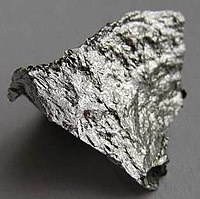

The image is of an antique electromagnet and a cow. The electromagnet is because manganese may have got its name from the Latin word for magnet. The cow reflects the importance of the element as a food supplement for grazing animals.
| Density | 7.3 |
| Melting Point | 1246°C |
| Boiling Point | 2061°C |
Manganese(IV) oxide is used as a catalyst, a rubber additive and to decolourise glass that is coloured green by iron impurities. Manganese sulfate is used to make a fungicide. Manganese(II) oxide is a powerful oxidising agent and is used in quantitative analysis. It is also used to make fertilisers and ceramics.
In 1740, the Berlin glass technologist Johann Heinrich Pott investigated it chemically and showed that it contained no iron as has been assumed. From it he was able to make potassium permanganate (KMnO4), one of the strongest oxidising agents known. Several chemists in the 1700s tried unsuccessfully to isolate the metal component in pyrolusite. The first person to do this was the Swedish chemist and mineralogist Johan Gottlieb Gahn in 1774. However, a student at Vienna, Ignatius Kaim, had already described how he had produced manganese metal, in his dissertation written in 1771.